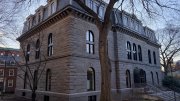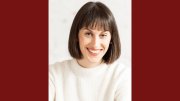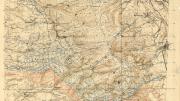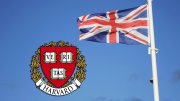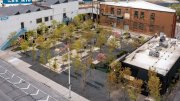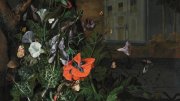As Hamas’s October 7 terrorist attack and the ensuing war in the Middle East reverberated on college campuses, some academic departments felt the impacts more acutely than others. Professors of Jewish studies, antisemitism studies, and Israel studies often saw their mandate change, as they took on responsibilities such as staffing task forces and providing pastoral care. On December 10, faculty from nine institutions gathered at Harvard to reflect on how the past year changed Jewish studies. The professors discussed the power of dialogue, advocated separating study and activism, and lobbied for antisemitism’s inclusion in campus conversations about discrimination.
Although the cochair of Harvard’s antisemitism task force, Frost professor of Jewish history Derek Penslar, convened the event through his role as director of Harvard’s Center for Jewish Studies, the University has not yet released its report on campus antisemitism. The conference provided insight into what sorts of recommendations have been offered elsewhere and what Harvard’s report may include.
Penslar opened the afternoon by situating the campus environment within a national context. “Disruptions on campuses are reflections of broader tensions in American society,” he said, noting that antisemitism is prevalent among the general American populace. Referencing University of California Irvine political scientist Jeffrey Kopstein, who spoke at a Harvard conference on hatred this May, Penslar said, “Campuses don’t have an antisemitism problem—America has an antisemitism problem.” Framing the afternoon, Penslar argued that colleges “are in a particularly strong position to combat antisemitism” due to their tight-knit communities and educated faculty.
In the afternoon’s first panel, “Perspectives on Current Campus Challenges,” four professors spoke about what their campuses looked like this year and how their departments responded. Maurice Samuels, professor of French at Yale University, talked about how the Yale Program for the Study of Antisemitism, which he directs, reassessed its mandate. He said that antisemitism centers can serve as forums for “debating these fundamental questions of what antisemitism is, how we should define it, and what we should do about it.” Samuels noted that he has previously shied away from “conflictual events,” but said that the best conferences he has attended have convened people who run “the full gamut of positions.” Those events, he continued, “made me realize how exceedingly rare it is to have conferences where people actually disagree, and also how crucial disagreement is for advancing understanding.”
Though Samuels said that antisemitism centers should embrace debate, he clarified that those disagreements should remain in the academic realm, and that such centers should not act as “the antisemitism police.” Throughout the past year, Samuels said, some of his colleagues have treated him “like a one-man Yale version” of the Anti-Defamation League, reporting specific instances of campus antisemitism to him. Though he does sit on Yale’s Jewish student life committee, the equivalent of Harvard’s antisemitism task force, Samuels said that not only does he not have the personal bandwidth to investigate individual incidents, but also that “an academic program for the study of antisemitism” is not the right body to define, investigate, and punish antisemitism on campus.
Instead, Samuels has focused on getting antisemitism included in campus conversations about race. “Jews are rarely seen as worthy of attention by scholars of critical race studies—except in a negative way in the case of Israel—despite the fact that so many theories of race were developed as a way to exclude Jews,” he said. He was recently asked to join the advisory board of the Yale Center for the Study of Race, Indigeneity, and Transnational Migration, he said, “which I take as a major step in the right direction.”
Other professors on the panel agreed that Jews should be included in campus race conversations. Anna Shternshis, professor of Jewish studies at the University of Toronto, who chairs its Jewish studies center, recounted a 2020 task force on campus antisemitism. Sparked by reports of antisemitic incidents at the University of Toronto medical school—including a lack of empathy towards Jewish patients’ pain and the harassment of Jewish doctors—the University convened an antisemitism working group. But Shternsis, who was a member of that group, said that the task force’s recommendations were “100 percent useless after October 7,” noting that the university still experienced an onslaught of antisemitism after the Hamas attack. There was one silver lining: the group got to know the campus’s DEI staff. After October 7, she said, 90 percent of DEI complaints were from Jewish students and faculty. Four years of collaboration prepared DEI staff to address those incidents, already armed with an understanding of antisemitism.
Despite DEI support, Shternshis reported that antisemitism and targeted anti-Israel sentiments are pervasive at the University of Toronto. She recounted Jewish and Israeli graduate students being removed from committees and faculty members dropping Israeli graduate students. Research collaborations with Israeli universities have become highly charged. Though the university states that its ties with Israeli institutions are strong, Shternshis said, “in practice, it became very difficult…to have any meaningful collaboration with Israeli universities.” But it’s not just Israel. She said that “collaboration with the Center for Jewish Studies is always now a brave choice.” Uttering “the word Jewish studies out loud is a political act,” she continued. But there are signs of hope: the university swiftly and fully funded a lab for the study of antisemitism following a request by Shternshis.
Shternshis said the current campus environment harkens back to her childhood in the Soviet Union. “Discrimination and the restrictions that Jews experienced in the Soviet Union were much, much worse than whatever is going on right now.” But, she continued, “in the Soviet Union, being publicly antisemitic was not an acceptable thing in the educated circles....Right now, what we see is exactly the opposite situation.”
Rebecca Kobrin, professor of American Jewish history at Columbia University and codirector of its Israel and Jewish studies institute, also turned to the past to understand the present. “The past we have been taught cannot explain the present we are witnessing,” she said. Kobrin spoke about how the mandate of Jewish studies professors has changed since October 7. “The pastoral care that we were forced to give was something I never before had experienced,” she said. Continuing, “I’ve learned how to fill out a police report, I’ve learned how to reformulate university rules for new governance and protests, I’ve served on the antisemitism task force…I also created an archive.” Kobrin authored Columbia’s second antisemitism report and has continued to host listening sessions since the report’s August publication.
Kobrin spoke about the role women played in the campus conflict. Columbia’s encampment, which made national news, was overwhelmingly female. She said that of the 91 students arrested at the first encampment, 58 were Barnard students (all female), 23 were female Columbia students, and only 10 were male Columbia students. She also noted that the university presidents who initially testified before Congress were all female, as were the presidents fired.
Columbia’s campus has been calmer this semester, she said. Kobrin attributed the relative calm to student fatigue (students’ grades suffered last year, and they want to get good jobs so are refocusing), internal division (the more radically pro-Palestine graduate students alienated the undergraduate protestors), and student turnover (a quarter of current undergraduates were not yet enrolled last spring). Though this moment of calm may be temporary, for a more permanent solution, Kobrin recommended emphasizing Jewish studies: “What happens in the classroom is how you change the narrative of what people think about.”
Dov Waxman, professor of Israel studies at the University of California Los Angeles (UCLA) who also directs its center for Israel studies, witnessed a campus that, at times, was even more chaotic than Columbia’s. On April 30, violent skirmishes broke out between protesters and counterprotesters, who attacked the pro-Palestinian encampment. The next evening, police broke up the encampment using rubber bullets. UCLA, a public university, was more restrained in how it could respond to the encampment than private schools like Columbia and Harvard, which both closed parts of their campuses to outsiders.
Waxman said that the tumultuous spring taught him some lessons about campus antisemitism. Too often, he said, antisemitism on campus has been discussed on social media and in Congress rather than on the campuses themselves. “Being a Jewish studies faculty [member] sometimes feels like you’re being told not to talk about what’s happening on campus,” he said. When discussing campus antisemitism, he said that people should acknowledge there is a true antisemitism problem without exaggerating its severity. He regretted previously doubting the pervasiveness of campus antisemitism, noting that he is neither visibly Jewish nor a student, so is not attuned to the full range of student experiences. But he also feels the media often exaggerated campus antisemitism, remarking that a friend from Israel, who survived the Hamas assault on his kibbutz, reached out to make sure Waxman was safe at UCLA.
To heal campuses, Waxman encouraged dialogue across difference. He applauded UCLA for including antisemitism in its initiative to study hate, though he acknowledged his hesitancy about the broad label of hate. He hopes that UCLA’s funding of constructive discourse programs will help make a difference in the coming years, slowly alleviating antisemitism on campus and throughout the country.
The conference’s second panel, “Teaching in a Time of Crisis,” featured four Jewish studies professors talking about pedagogical strategies and changes. Magda Teter, professor of Judaic studies and history at Fordham University, spoke about what antisemitism studies could learn from other fields. “Black studies and racism studies study the impact of racism on its victims,” she said. “Antisemitism studies make the victims invisible or implicated. We study the perpetrators, we study the antisemites.” Black studies scholars, she continued, spend much less time arguing about definitions of racism. “When we teach about antisemitism, only through the language of perpetrators…we are effectively amplifying the voices of antisemites and antisemitic tropes while eliminating…the voices of those who are affected by the antisemitic tropes.”
Teter hoped that academics could bridge the gap between antisemitism studies and Jewish studies, which does a better job teaching about Jews as people rather than mere subjects of hate. At Fordham, Jewish studies classes are incorporated into the core curriculum. Students from all backgrounds, merely seeking core credits, “end up learning about Jews as human beings, not caricatures.”
Jonathan Gribetz, professor of Judaic studies at Princeton University, described universities as the perfect place for such wide-ranging learning. He said that colleges have the potential for “inquiry l’shma,” inquiry for its own sake. “Where else these days do people ask questions, not to prove a predetermined point,” he said, “but because they want to know the answers?” He argued that the classroom should be a place of collaborative learning rather than hostile debate. At the beginning of the course he teaches on the Arab-Israeli conflict, he tells students that the class is about the conflict, not itself the conflict.
Alexander Kaye, professor of Israel studies at Brandeis University, hoped that relevant knowledge acquired in the classroom would not remain confined within the university. He said that the “deeply troubling rise in antisemitism” can be traced to polarization and lack of verifiable information. “At its best, the university classroom is nothing less than the antidote…to these ills.”
Kaye runs an annual summer institute for Israel studies, where professors from around the world who want to teach about Israel-Palestine learn at Brandeis for ten days before traveling to Israel and Palestine. After October 7, a former participant, a professor from Morocco, emailed Kaye to ask how to teach about the Hamas attack. “It might be surprising to know that a Muslim in a Muslim-majority country at a Muslim-majority University is writing to us at Brandeis University to figure out how to teach about Israel and Palestine in this particularly awful moment,” he said. But Kaye was not surprised. “We as a community had built up a trust among each other that you know, perspectives and viewpoints are all welcome, as long as there is respectful and curious engagement with each other.” Kaye expressed hope that universities will continue to be a model for civil discourse.
Ethan Katz, professor of history at the University of California Berkeley and director of its center for Jewish studies, agreed that universities need to do a better job of sharing information with the public, but cautioned that academic work should not cross the line into advocacy. “Advocacy and activism are fundamentally about achieving a political victory," he said. Whereas, "education is fundamentally about advancing knowledge and understanding."
For a model of how academics could contribute to the public good, he reflected on Berkeley’s antisemitism education initiative, convened in 2019 after a student government meeting in which Zionism was mocked and Jewish students were told that they knew nothing about oppression. Through that program, Katz realized the benefit of having the center for Jewish studies partner with Hillel, a Jewish student organization. He brought academic credibility, while the Hillel rabbi brought student life credibility. “I think that we are often reluctant to make these collaborations,” he said, but this one helped strengthen the antisemitism education initiative.
A year into the war in the Middle East, campuses are still figuring out how to deal with its ramifications. These nine professors provided a loose model: lean on existing university strengths, including academic departments and student communities, to educate by engaging with different opinions. In the coming weeks, Harvard’s antisemitism task force report may suggest a more concrete path to heal campus divisions and encourage tolerance rather than hatred.
